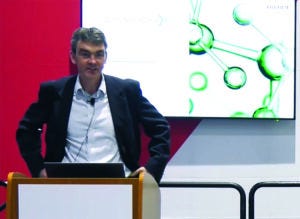- Sponsored Content
- Single Use
Advancing Biomanufacturing Capabilities with a Next-Generation Single-Use SolutionAdvancing Biomanufacturing Capabilities with a Next-Generation Single-Use Solution
August 24, 2022
Sponsored by Fujifilm Diosynth Biotechnology
 Charles Heise, senior staff scientist in bioprocessing strategy and development group, Fujifilm Diosynth Biotechnologies.
Charles Heise, senior staff scientist in bioprocessing strategy and development group, Fujifilm Diosynth Biotechnologies.
Heise presented work Fujifilm Diosynth Biotechnologies has done to debottleneck downstream processes for continuous operations and high-titer product batches. He highlighted the benefits of automation and data management, closed processing, and advanced buffer management — all together in the SymphonX system. A disposable flow path provides buffer-management capability through standard software for “multifunctional” operations.
The company wanted one “rig” to perform all the necessary downstream functions, Heise said, to derisk and simplify multiproduct facility operations. For different filtration and chromatography operations, that requires a dynamic range of capabilities. “You need to control using not only flow rate, but also pressure,” he explained. The system also needed flexibility in valve control, enabling operators to change flow paths and control what was happening within each path. That required on-board sensors and standard process analytics.
Heise described the flow paths as “single-product” rather than “single-use” components. The system runs chromatography columns ≤45 cm i.d. and ≤5 m2 of tangential-flow filtration (TFF) membrane area either in batch or continuous mode. Robustness and durability are important, as is materials compatibility — both for cleaning methods and long product-exposure periods. Flow-path components are gamma-irradiated before use, so integrated sensors need to withstand that procedure as well as maintain a closed system.
“When you connect a unit operation to the flow path,” Heise said, “that defines what the operation becomes. Connecting a column or filter defines what the flow path needs to be.” Flexibility facilitates process design while giving the company needed agility in capacity use.
Heise highlighted the system’s buffer-management capabilities. Using a single pump with proprietary algorithms, the rig can generate fixed-gradient mixes for isocratic buffers as well as generate buffer gradients by changing the component ratios over time. It can use concentrates as well as formulated buffers during processing. Multiple inlets provide for acid–base salt mixes, so users can make different buffers from stock concentrates. Mixing is flow-rate independent.
That enables a point-of-use, in-line dilution strategy. A valve block cycles to dose different components into the mixing chamber at ratios determined by how long each valve stays open. The overall recipe is controlled by a duty cycle defined by flow rate or another specified parameter. Ultimately, that minimizes the facility footprint of buffer operations — although using buffer concentrates will increase water use. The system requires a proprietary mixer that, combined with the valve and pump system, enables accurate buffer dosing and mixing to homogeneity just before use.
“We can run the rig from about 6-L/h to about 700-L/h flow rates,” Heise reported. “We can mix 5–95% between two buffers.” He showed an example with validation data from two- and threefold dilutions of stock concentrates.
Modular software allows operators to build recipes or execute stored methods and view results, with secure data transfer for 21 CFR part 11 compliance. The system can operate either on its own or as part of a network. Multiple rigs can be connected, with material feeding from one unit to the next. The company is testing a good manufacturing practice (GMP) version of its software and expects to have that in place by early 2023. Heise said that “the move to automation and biopharma industry 4.0 capability is built in.”
Thus far, his company has used the SymphonX system in six different drug-substance manufacturing programs delivering material for early clinical trials in batch processes outside of the GMP space. Test runs have been performed under GMP conditions. “We’ve also demonstrated continuous operations by linking rigs together,” Heise said. He showed example chromatograms from a capture step and an intermediate polishing step using 5× buffer concentrates in a continuous process, as well as results from an ultrafiltration/diafiltration (UF/DF) process also using concentrated buffers.
Heise said that his company is innovating in downstream processing in response to customer needs. “We are developing a whole family of these rigs to work at different scales and meet different requirements of cell and gene therapies, proteins, and RNA.” The company also is building a facility that will support a 500-L GMP continuous manufacturing stream and should go online in 2024. The SymphonX system is designed to support capacity increases and enable Fujifilm Diosynth Biotechnologies to produce client materials in the right quantities for clinical supplies and product launch. “We see this as a way to augment upstream batch-intensification activities to make sure that we’re not bottlenecking process downstream.”
Fill out the form below to view the full BPI Theater presentation.
You May Also Like






